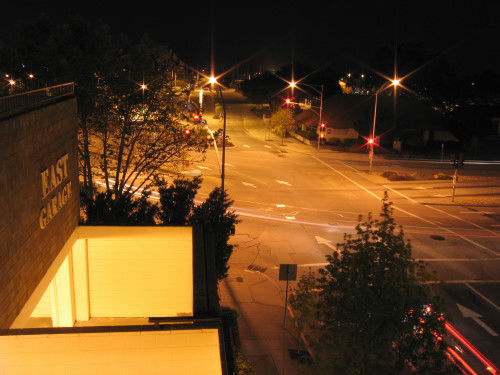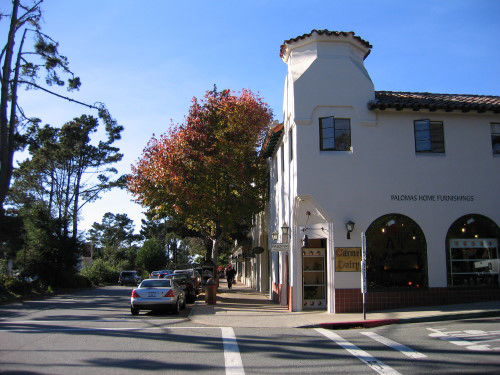"A good driver is a smooth driver."
-What Mr. Toy's mother said during his first driving lesson.
Finding your way around the Monterey Peninsula can be a challenge. Streets and roads here aren't normal. Monterey's streets are particularly confusing because they were laid out before the wheel was invented.
One nice thing about the Monterey Peninsula is that everything is pretty close to everything else. With the exception of Big Sur and Carmel Valley, you can get almost anywhere on the Peninsula from anywhere on the Peninsula in 15 minutes or less. OK, sometimes more if traffic is bad.
Study a map before you start the car. Make it a paper map. Online maps and GPS are handy things, but they're no substitute for laying out a map on the kitchen table to see how everything fits together. Once you're on the road, have a navigator looking for the handy signs directing you to various attractions. If you miss your turnoff, don't make a last ditch effort to try to make it anyway! Such rash decisions cause accidents and makes you look like a stupid tourist. If you're smart enough to operate a computer, you're smart enough to go around the block or to the next exit.
If you get lost, don't panic. Use the opportunity to discover things you might not have found otherwise. It can be reassuring to remember that you can never get too far from a main road, so you'll run into one eventually. If you need to get your bearings, pull over. Don't try to read your gadgets while going three miles an hour. (We see such behavior all too often, and we don't like it!)
The large numbers of visitors, such as yourself, can sometimes cause terrible road congestion. If you have little patience with traffic jams, Mr. Toy suggests you stay away during the following time periods:
Local residents try to stay home on those days if they can help it. To avoid the worst traffic jams altogether, visit in the fall or winter.
When driving around here at night, please use your high-beams whenever you can, especially in and around Carmel. There are lots of nocturnal animals about, including deer, raccoons, and house cats. They can be difficult to see with just your low-beams, and when you feel that horrible sensation of an animal going bump under your wheels you'll be bummed for the rest of the evening.

Downtown Monterey is the second oldest city in the western United States. Its street layout doesn’t conform to our modern expectations where streets run parallel and city blocks are rectangular. Many streets in Monterey run diagonally. Some blocks have only three sides, others have five. Even the streets that look parallel aren’t quite so. To further confuse matters, some streets change names every few blocks. In the case of Munras Avenue, you have to turn onto other streets twice if you want to stay on Munras.
The City of Monterey has delibrately done some things that further confuse tourists. We're not suggesting the confusion was intentional, but clearly they did not think things through.
Consider Fremont. Fremont is one of two major east-west boulevards. It runs from downtown Monterey eastward where it eventually turns north into Seaside. It used to be part of Highway 1. In 1967 the freeway came through and bypassed most of Fremont, but in the process also bisected it. By the mid 1980s business owners were complaining that the portions of Fremont on each side of the freeway could not be distinguished from each other on paper. So, in an act of bureaucratic brilliance, the eastern portion was named North Fremont. Just remember North Fremont is east of Fremont in Monterey and southwest of Fremont in Seaside. It isn't north of anything else named Fremont. Wasn't that easy?
If that is not confusing enough the intersection of Del Monte and Figueroa has a big, beautiful red and blue sign that says "Old Fisherman's Wharf." Why they placed it in front of the other wharf is something only a city bureaucrat can understand. You can enter the parking lot for both wharves there, but the actual Fisherman's Wharf is one block west, and is marked by a smaller sign.
On summer weekends and holidays you may find some pretty heavy traffic along Del Monte Avenue in the vicinity of the wharves. The westbound lanes are especially bad. The right lane moves the slowest due to all of the people trying to turn right into the wharf parking lot. They are hindered by the heavy pedestrian traffic on the crosswalk. As a result, it may take two or three green lights for you to move a single block in this lane. The two left lanes move quite a bit faster.
Also in this area Del Monte splits in two directions. The left lane becomes two lanes and leads downtown. The center and right lanes turn towards the Custom House Tunnel and lead to Cannery Row, New Monterey, and Pacific Grove. Plan ahead here for lane changes can be difficult.
If you are traveling in the opposite direction, from Cannery Row, you will find a light at the end of the tunnel. A stoplight. You need to know that you can't turn left into Fisherman's Wharf at that light, tempting as it may be. You have to go one block farther to Figueroa and turn left there, then backtrack through the parking lot.
Also, be aware that the tunnel can back up quite a ways during rush hour. You can avoid this by taking the Pacific Street exit just before the tunnel entrance. Take Pacific to Franklin and turn left. After you pass downtown you can jog back over to Del Monte, one block north of you. There may also be heavy traffic on this route, but at least you won't be sitting in a tunnel full of exhaust fumes.
What about parking? The city provides a lot of lots, garages, and on-street parking in the downtown and Cannery Row neighborhoods. Most parking options will cost you something. Some areas have free street parking, but with strict time limits. The city's Parking Page will fill in the details.

Never drive to Carmel if you are in a hurry. If the traffic doesn't slow you down, the scenery will, and if the scenery doesn't slow you down you might as well go home.
Carmel street signs are a little weird. They're on white posts and read vertically, not horizontally. It takes a little getting used to. But when you see them, you'll know you are within the city limits of Carmel. Those outside the city limits are the regular, horizontal crosses on top of poles.
Carmel addresses have no street numbers. Shocking as this sounds, it's true. They have no street numbers because there is no formal mail delivery. Almost everyone goes to the post office. It's a deeply ingrained social ritual that dates back to the earliest days of the village when everyone gathered their mail at the stationery store.
Anyway, to find a building you must know the nearest cross street. Businesses will be listed in the phone book with something like "Dolores and 7th," meaning it faces Dolores, and is near 7th. Just how near never clear. Residences are named, rather than numbered, such as "Doubletree," "Twin Pines," "Carmelot," "Tea for Two," and "Xanadu". There used to be a house named "This Is It," while the house next door said "This Isn't." But, alas, someone lost their sense of humor and changed them.
The good news about Carmel is that most of the streets are laid out in a simple grid pattern. To further simplify things, named streets run north and south, while numbered streets run east and west. The only significant exception to this rule is Ocean Avenue, an east-west street that lies between 6th and 7th. Think of Ocean as 6th-and-a-half Street.
Parking regulations are strictly enforced in Carmel! Most spaces are good for two hours, but some, usually on the street corners, are only good for 30 minutes. Move your car when the time is up, or you'll get a ticket, guaranteed. Parking enforcement officers are everywhere, ready to pounce on anyone who lingers. They do this partly to free up space for others, and partly for the money. OK, mostly for the money. If you don't want to keep moving your car, you can park as long as you want in the parking lot at the corner of Mission and 8th. If you don't mind walking uphill after you shop, there's another lot on Junipero and 3rd called Vista Lobos (because you can see Point Lobos from there) that's good all day. Junipero also has unlimited street parking between 3rd and 5th Avenues. Please note: The information in this paragraph may be subject to change.
A few words and opinions about Highway 1 at Carmel: For over 40 years Caltrans (the cutesy name for the state department of transportation) thought it would be a really neat idea to build a freeway bypass through a canyon which lies just east of Carmel. This would have required tearing up the landscape that everyone, residents and tourists alike, prize so dearly. (It also would have destroyed Mr. Toy's childhood home.) Instead of undoing our horrible traffic jams, all Caltrans did was create bitter divisions among the local citizenry. In March 1999 the project was finally killed. Mercifully, in the spring of 2002 a second northbound lane was added south of Ocean Avenue and, contrary to the predictions of the best minds at Caltrans, decades of gridlock at the mouth of Carmel Valley was pretty much eliminated overnight.
However, the southbound side of Highway 1 still suffers from a one-lane bottleneck between Ocean Avenue and Carmel Valley. Southbound travelers are advised to use the right lane as you approach Ocean Avenue. It mover faster because many of the cars in the right lane will be exiting at Ocean Avenue, freeing up pavement, while those in the left lane are all planning to stay there. The left lane folks end up sitting through several cycles of the traffic light under the mistaken idea that they are in the "fast lane" while cars in the right lane zip past them.
If you are looking for a particular street, make sure you know which city it is in. Several local cities use common street names that have no connection to each other. For example, Monterey, Pacific Grove, and Carmel all have numbered streets. If you want directions to an address on 6th, for example, be sure to specify the city.
Carmel and Monterey both have an Ocean Avenue. One is famous, the other is not. Make sure you get the right one to avoid disappointment.
Just northwest of Monterey is Pacific Grove. Both cities have a street called Lighthouse Avenue. They both end at the city limits (David Avenue) exactly one block apart from each other. The Lighthouse in Monterey becomes Central Avenue in P.G., while the Lighthouse in P.G. becomes Hawthorne in Monterey. They all run parallel, more or less. This little quirk can drive you nuts until you figure it out.
Similarly, Pacific Grove and Pebble Beach both have a Congress Avenue and they end just a short distance from each other. The only thing that separates them is the entry gate to Pebble Beach where you pay your admission fee. This is fitting, for nothing goes through Congress that doesn't end up costing us money.
Of course, you could give up on the whole driving experience and ride the bone-rattling Monterey-Salinas Transit bus, but deciphering their timetables is even more confusing than navigating local streets on your own.
HTML Website Creator